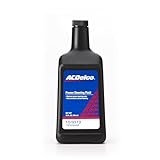Milky Power Steering Fluid
Have you ever popped your hood and noticed something unsettling? A cloudy, milky substance in your power steering fluid? This article will explain what milky power steering fluid means, why it’s a problem, and how to address it. We’ll cover causes, solutions, and prevention, leaving you with a much clearer understanding of your car’s vital
systems.
Understanding Milky Power Steering Fluid
What is Power Steering Fluid and Why is it Important?
Power steering fluid is a hydraulic fluid that assists your car’s steering system, making it easier to turn the wheel, especially at low speeds. It’s a crucial component; without it, steering your car would require significantly more effort, potentially leading to accidents. This fluid operates under pressure, transferring power from a pump to the steering gear. Think of it like the blood in your body; it’s constantly circulating and needs to be clean and free-flowing for the system to function correctly. The quality and condition of your power steering fluid directly impact the performance and longevity of your steering system. A degraded fluid can lead to a variety of issues, from sluggish steering response to complete system failure. Ignoring a problem with your power steering fluid could lead to expensive repairs down the line.
The Telltale Signs of Milky Power Steering Fluid
The most obvious sign of a problem is the appearance of the fluid itself. Instead of its usual clear, red, or amber color, it will look milky or cloudy, like a mixture of oil and water. This milky appearance usually indicates contamination with water, which can cause significant damage. Other signs you might notice include: a groaning or whining noise from the power steering pump, difficulty turning the steering wheel, especially at low speeds, and leaks from the power steering system. These symptoms combined with the visual indication of milky fluid often point towards a serious issue that needs immediate attention. I once had a similar experience with my old Honda Civic; the fluid started looking cloudy, and the steering became noticeably stiffer, ultimately leading to a much more extensive and costly repair than if I’d addressed it early.
The Dangers of Ignoring Milky Power Steering Fluid
Ignoring milky power steering fluid is dangerous and can lead to serious issues. The water contamination causes corrosion and internal damage to the pump, hoses, and other components of the system. This can lead to complete power steering failure, making steering incredibly difficult and dangerous, especially at higher speeds. Moreover, the contamination can cause the fluid to become less effective at lubricating the system, causing increased wear and tear on the mechanical components. In extreme cases, this can result in a complete breakdown of the steering system, making the car unsafe to operate. This is why it’s crucial to address the issue swiftly and accurately.
Causes of Milky Power Steering Fluid
Water Ingress: The Primary Culprit
The most common reason for milky power steering fluid is water contamination. This water can enter the system in several ways. A leak in the power steering system’s seals or hoses can allow rainwater or moisture to seep in. A damaged power steering pump seal can also permit water entry. Additionally, condensation can build up within the reservoir over time, especially in cold climates. This is why regular inspection and maintenance are vital to prevent these issues. Think of it like a poorly sealed container – if it’s not properly maintained, external elements can compromise the integrity of the contents.
Damaged Power Steering System Components
Leaks within the power steering system are common culprits. These leaks can occur in the hoses, seals, or even the pump itself. A compromised seal allows the fluid to escape, and often, moisture to enter. This process of fluid loss and water ingress leads to the milky appearance and can severely impact performance. Similarly, a failing power steering pump can introduce particles into the fluid, further impacting its condition. Regular fluid checks and preventative maintenance help prevent this.
Faulty Power Steering Rack and Pinion
The power steering rack and pinion are critical components that translate the power steering fluid’s pressure into steering motion. If these components are damaged, the seals within them may leak, leading to the entry of water and the milky appearance of the fluid. This can result in decreased steering response and potentially a complete failure of the system. The rack and pinion is a precision component, and the fluid needs to be in optimal condition for it to function properly.
Diagnosing the Problem
Visual Inspection: The First Step
The first step in diagnosing the problem is a visual inspection. Check the power steering fluid reservoir for the telltale milky appearance. Compare the fluid to the recommended fluid level and color on your car’s manual for accurate diagnosis. Note the level of the fluid as well; low levels combined with milky fluid may indicate a leak. A thorough inspection of all hoses and components is crucial, looking for any signs of leaks or damage.
Testing the Fluid
Beyond a visual inspection, testing the power steering fluid can be beneficial. There are specialized tests that determine the moisture content of the fluid; higher than normal moisture content confirms water contamination as the cause. In addition, checking the fluid for the presence of metal shavings or other contaminants will help diagnose the root cause of the problem. A clean and clear fluid usually indicates a functioning system, while a dirty or contaminated fluid indicates potential problems.
Professional Diagnosis
If you’re unsure about the cause of the milky power steering fluid, take your car to a qualified mechanic. They have the tools and expertise to properly diagnose the problem and provide accurate repair recommendations. Attempting to repair it yourself without sufficient knowledge could lead to further damage and increase the overall cost of repairs.
Repairing Milky Power Steering Fluid Issues
Flushing the System: A Partial Solution
In some cases, particularly if the contamination is minor, flushing the power steering system may solve the problem. This involves draining the old fluid, thoroughly rinsing the system, and refilling it with fresh fluid. This is typically a cost-effective solution, but it doesn’t always address underlying issues like leaks. It’s important to remember that flushing alone won’t repair damaged components.
Repairing or Replacing Damaged Components
If the milky power steering fluid is caused by leaks or damaged components, those components will need repair or replacement. This might involve replacing hoses, seals, or even the power steering pump or rack and pinion. This repair can be considerably more expensive than a simple fluid flush, but it’s necessary to prevent further damage and ensure the safety of the vehicle. I’ve learned from experience that ignoring this type of issue can lead to far greater problems later on.
Preventive Measures
Preventative maintenance is vital to avoid this issue. Regular inspection of the power steering fluid reservoir and a regular fluid change (according to your car manufacturer’s recommendations) is crucial. Inspecting the hoses and seals for leaks and cracks is also important. Early detection is key to avoiding costly repairs, and many of the preventative steps are relatively inexpensive and simple to perform.
Preventing Future Problems
Regular Fluid Changes
Following your car manufacturer’s recommended schedule for power steering fluid changes is paramount. This ensures the fluid remains clean and free of contaminants, preventing future problems. Regular fluid changes flush out old fluid and contaminants, ensuring the system operates at peak performance.
Inspecting the System Regularly
Regular visual inspections of the power steering fluid reservoir and associated hoses are important. Look for leaks, discoloration, or anything unusual. This allows for early detection of problems before they become major issues. A simple visual inspection takes only a few minutes and can save you from a lot of trouble and expense later on.
Maintaining the System
Keeping the power steering system properly maintained involves addressing any leaks immediately, replacing damaged hoses and seals, and ensuring the power steering pump is functioning correctly. Neglecting even minor problems could compound over time and result in more severe damage and more costly repairs.
Power Steering Fluid Types and Compatibility
Understanding Fluid Specifications
Different vehicles require different types of power steering fluid. Refer to your owner’s manual to determine the correct type for your car. Using the incorrect fluid can lead to compatibility issues, potentially causing damage to the system. There is no universal fluid that works in all vehicles; using the right one is crucial.
Checking for Compatibility
If you’re unsure about the fluid type, consult your owner’s manual or a qualified mechanic. Using an incompatible fluid can cause immediate issues, including damage to seals and internal components. Improper fluid can quickly turn your power steering system from a helpful asset into a serious liability.
Avoiding Mixing Fluids
Never mix different types of power steering fluids. Mixing incompatible fluids can cause chemical reactions, resulting in sludge, damage to components, and potentially a complete power steering failure. Always use the recommended fluid only, adhering to the manufacturer’s specifications.
The Cost of Repair
Factors Affecting Repair Costs
The cost of repairing milky power steering fluid problems varies significantly depending on the severity of the issue. A simple fluid flush might cost a few hundred dollars, while replacing the pump or rack and pinion could run into thousands. The location of the repair also affects the cost; different regions have different labor rates.
Budgeting for Repairs
It’s essential to budget for potential power steering repair costs. Unexpected repairs can put a significant strain on your finances; preparing for this possibility can help mitigate stress if a problem arises. Keeping emergency funds dedicated to vehicle repairs is always wise.
Comparing Repair Options
When considering repair options, be sure to weigh the costs against the benefits and the long-term implications. Attempting to skimp on necessary repairs could lead to more significant issues later, resulting in far higher costs. Consulting with your mechanic to understand all the options available is wise before making decisions.
Frequently Asked Questions
What is milky power steering fluid best for?
Milky power steering fluid isn’t “best” for anything; it’s an indicator of a problem. The milky appearance signifies water contamination within the power steering system, leading to damage and potential failure. It indicates a need for immediate attention and repair to prevent further issues. Learn more about diagnosing the root cause of milky power steering fluid.
How often should I check my power steering fluid?
You should check your power steering fluid level as part of your regular vehicle maintenance checks. The frequency depends on your car and driving habits, but at least monthly is a good rule of thumb. Consult your owner’s manual for specific recommendations. Learn more about preventative maintenance for your car’s steering system.
Can I top off milky power steering fluid?
No, you should not top off milky power steering fluid. The milky appearance indicates contamination, and adding more fluid will only dilute the existing fluid and potentially prolong the issue. The system requires a thorough flush and likely repair before refilling with fresh fluid. Learn more about flushing your power steering system.
What causes power steering fluid to turn milky?
The most common cause is water contamination. Water can enter the system through leaks in hoses, seals, or a damaged pump. Condensation can also contribute to the problem. Learn more about diagnosing leaks in your power steering system.
How much does it cost to repair milky power steering fluid?
The cost depends on the severity of the issue. A simple fluid flush might be relatively inexpensive, while replacing damaged components can be quite costly. A mechanic can provide a more accurate estimate after diagnosing the problem. Learn more about power steering system repair costs.
Can I drive with milky power steering fluid?
While you might be able to drive with slightly milky fluid, it’s generally not advisable. Driving with heavily contaminated fluid can cause further damage, leading to steering difficulties and ultimately, a complete system failure. Avoid driving the vehicle until the problem is addressed. Learn more about the risks of ignoring power steering issues.
What are the long-term effects of ignoring milky power steering fluid?
Ignoring milky power steering fluid can cause corrosion, wear, and tear on system components, eventually resulting in complete power steering failure, making the vehicle dangerous to drive. This can lead to costly repairs and potential accidents. Learn more about the dangers of neglecting your car’s power steering system.
Final Thoughts
Milky power steering fluid is a serious issue that requires prompt attention. While a simple fluid flush might suffice in minor cases, more significant problems demand repairs or replacements of damaged components. Regular inspections, preventative maintenance, and adherence to your car manufacturer’s recommended service schedule are crucial to preventing costly repairs and ensuring your vehicle’s safe operation. Don’t ignore the warning signs; address the problem before it becomes a safety hazard. Your safety and peace of mind are worth the effort and cost of keeping your power steering system in top working condition. Remember, a functioning power steering system is essential for safe and comfortable driving.

David Peterson, the chief editor of sparepartscare. I am an automobile engineer and assign to an local firm with much experience in automobile equipment. During the time, most of my experience is related to the Industry of cars parts. I learned about the thing, when working with experienced inspectors, one must be as good as the inspector, or better, with knowledge of the project as well as the practical aspects of automobile industry.











